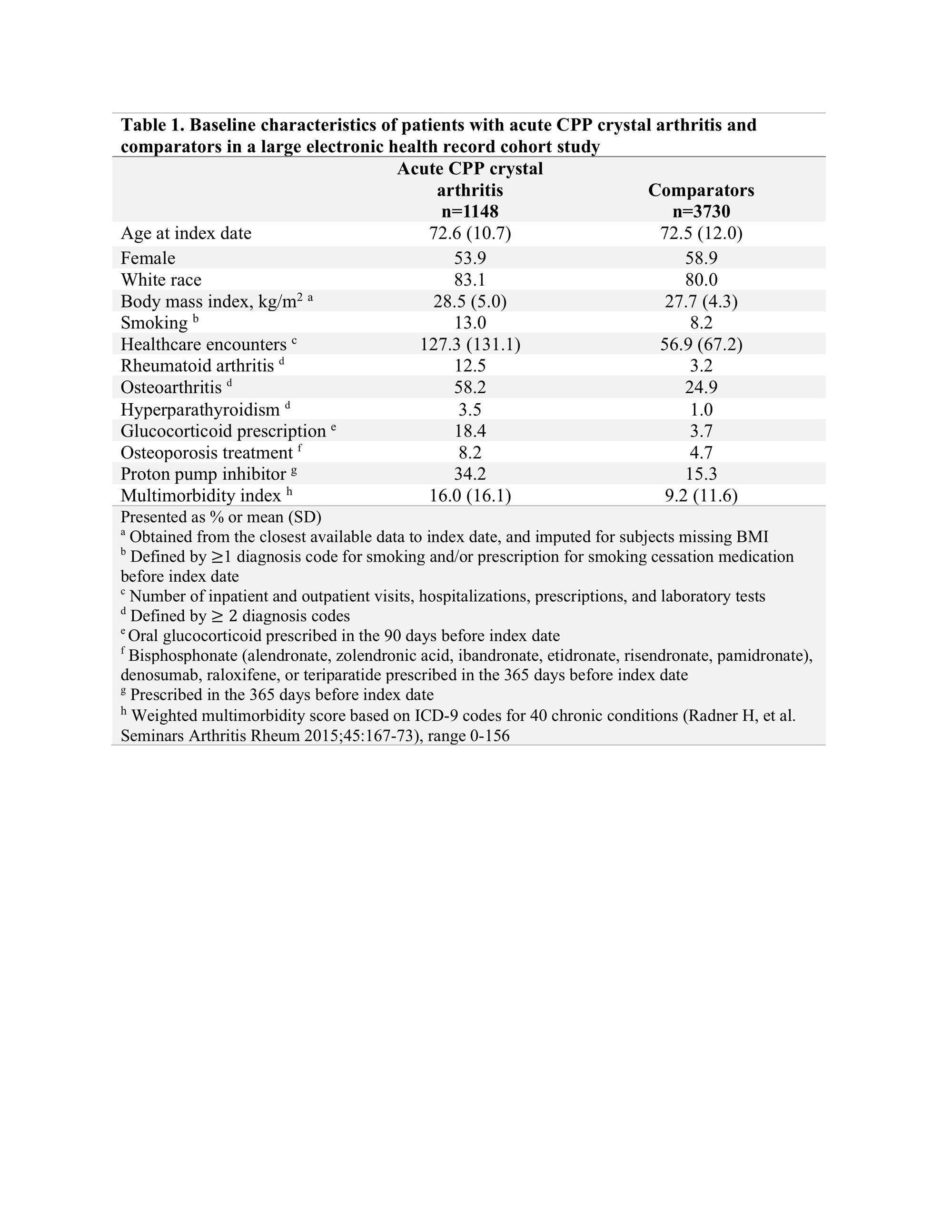Session Information
Date: Sunday, November 12, 2023
Title: (0229–0251) Metabolic & Crystal Arthropathies – Basic & Clinical Science Poster I
Session Type: Poster Session A
Session Time: 9:00AM-11:00AM
Background/Purpose: Calcium pyrophosphate deposition (CPPD) disease was positively associated with osteopenia in two large cross-sectional studies, but risk of fractures has not been evaluated. We compared risk of fractures in patients with acute calcium pyrophosphate (CPP) crystal arthritis vs. matched comparators.
Methods: We performed a matched cohort study using electronic health record (EHR) data at a large academic medical center. Patients with at least one episode of acute CPP crystal arthritis, 1991-2017, were matched to comparators without acute CPP crystal arthritis on index date and year of EHR entry; comparators could have other types of arthritis. Index date was the 1st mention of “pseudogout” in notes or 1st synovial fluid analysis with CPP crystals, whichever came first. For the matched comparators, an encounter +/- 30 days was used as the index date. The primary outcome was first fragility fracture (humerus, wrist, hip, or pelvis fracture); secondary outcomes were first fracture at each separate anatomic site. Fragility fractures were identified via published algorithms using diagnosis and procedural codes with positive predictive value >90%. For patients with >1 fracture, only the earliest was included. The baseline period from EHR entry through index date was required to be ≥180 days. Patients with baseline fragility fracture were excluded. Covariates included age, sex, race, smoking, rheumatoid arthritis, hyperparathyroidism, healthcare encounters, multimorbidity index, BMI, oral glucocorticoids, osteoporosis treatment, and proton pump inhibitors. Censoring occurred at the earliest of death, fracture outcome, or last encounter before April 2023. We estimated incidence rates (IR) and IR ratios (IRR) for any fracture and for each anatomic site. Cox models estimated adjusted hazard ratios (HR) for fractures. Sensitivity analyses excluded patients prescribed glucocorticoids, osteoporosis treatment, or with rheumatoid arthritis.
Results: We identified 1148 patients with acute CPP crystal arthritis matched to 3730 comparators. Mean age was 73 years in both cohorts and more than half were female. Glucocorticoids and osteoporosis treatments were more frequent in the acute CPP crystal arthritis cohort than comparators (Table 1). Fracture incidence rates were twice as high in the acute CPP crystal arthritis cohort (11.2 per 1000 person-years) vs. comparators (5.6 per 1000 person-years) (Table 2). Cumulative incidence curves increasingly diverged, reflecting greater fracture rates in the acute CPP crystal arthritis cohort over time (Figure 1). Fracture risk was twice as high in the acute CPP crystal arthritis cohort vs. comparators after adjustment (HR 1.8, 95% CI 1.4, 2.4); results were similar in sensitivity analyses excluding patients using glucocorticoids, osteoporosis treatments, or with rheumatoid arthritis (Table 2).
Conclusion: In this first-ever study of fractures and CPPD, we observed a doubling of fracture risk in patients with acute CPP crystal arthritis. Future studies evaluating bone turnover markers and changes in bone density over time in patients with CPPD are needed.
To cite this abstract in AMA style:
Tedeschi S, Hayashi K, Rosenthal A, Marrugo J, Fukui S, Gravallese E, Solomon D. Fractures in Patients with Acute CPP Crystal Arthritis versus Matched Comparators in a Large Cohort Study [abstract]. Arthritis Rheumatol. 2023; 75 (suppl 9). https://acrabstracts.org/abstract/fractures-in-patients-with-acute-cpp-crystal-arthritis-versus-matched-comparators-in-a-large-cohort-study/. Accessed .« Back to ACR Convergence 2023
ACR Meeting Abstracts - https://acrabstracts.org/abstract/fractures-in-patients-with-acute-cpp-crystal-arthritis-versus-matched-comparators-in-a-large-cohort-study/



